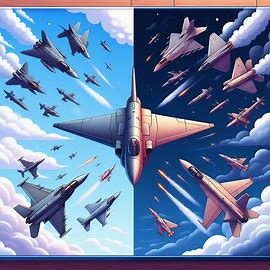
Introduction
In the vast and complex world of military aviation, terms like “military jets” and “fighter planes” are often used interchangeably by the public. However, these terms, while related, represent distinct concepts that define the roles, capabilities, and types of aircraft used by modern air forces. Understanding the difference between military jets and fighter planes is crucial for appreciating their unique contributions to air combat and defense.
This comprehensive article delves into the nuances of military jets and fighter planes, explores their history, classifications, technological differences, operational roles, and future trends. Whether you’re an aviation enthusiast, student, or professional, this guide will clarify common misconceptions and provide a detailed perspective on these pivotal aircraft types.
1. Defining Military Jets and Fighter Planes
1.1 What Are Military Jets?
Military jets refer broadly to any jet-powered aircraft used by a country’s armed forces. The term encompasses various types of aircraft, including fighters, bombers, reconnaissance planes, and transport jets. What unites them is the use of jet engines, which provide superior speed and performance compared to propeller-driven aircraft.
Military jets can be categorized by their specific mission:
-
Fighter jets – designed primarily for air combat.
-
Bomber jets – optimized for long-range attacks on ground targets.
-
Reconnaissance jets – equipped for intelligence gathering.
-
Transport jets – used for rapid movement of troops and equipment.
1.2 What Are Fighter Planes?
Fighter planes, also known as fighter aircraft, are a specialized subset of military jets focused primarily on air-to-air combat. Their main role is to establish air superiority by engaging enemy aircraft, protecting friendly forces, and intercepting incoming threats.
Fighter planes have distinct design and performance characteristics:
-
High speed and agility
-
Advanced weaponry such as air-to-air missiles and guns
-
Sophisticated radar and sensor systems for target detection
While all fighter planes are military jets, not all military jets are fighters.
2. Historical Evolution and Context
2.1 The Birth of Military Jets
The first military jets emerged during World War II, revolutionizing air combat with the introduction of jet propulsion. The German Messerschmitt Me 262 was the world’s first operational jet fighter, drastically outperforming piston-engine planes.
Post-war, jet technology rapidly evolved, leading to diverse jet aircraft types serving different military functions.
2.2 The Evolution of Fighter Planes
Fighter planes have seen remarkable changes in design and capabilities, evolving through generations:
-
First generation: Subsonic jets with basic radar.
-
Second generation: Supersonic capabilities and guided missiles.
-
Third generation: Improved avionics and multi-role functionality.
-
Fourth generation: Enhanced agility, fly-by-wire systems.
-
Fifth generation: Stealth, sensor fusion, and advanced networking.
Each generation improved the effectiveness of fighters in combat, with modern fighter planes integrating technologies that make them formidable in both offensive and defensive roles.
3. Design and Technological Differences
3.1 Engine Types and Performance
Military jets use turbojet or turbofan engines designed for high-speed flight. Fighter planes often have engines optimized for rapid acceleration, high thrust-to-weight ratios, and supercruise capabilities (sustained supersonic flight without afterburners).
Key points:
-
Fighter engines prioritize agility and maneuverability.
-
Bomber or transport jets focus on fuel efficiency and range.
3.2 Airframe and Aerodynamics
Fighter planes have sleek, lightweight designs for maximum maneuverability and stealth. Military jets can vary widely:
-
Fighters: Small, agile, low radar signature.
-
Bombers: Large, robust for carrying heavy payloads.
-
Reconnaissance: Equipped with specialized sensor pods.
-
Transport: Designed for heavy lifting, often with large fuselages.
3.3 Avionics and Weapon Systems
Fighter planes are equipped with cutting-edge radar, electronic warfare systems, and air-to-air missiles. Military jets like bombers may carry different payloads such as guided bombs or cruise missiles.
4. Roles and Missions in Modern Air Forces
4.1 Fighter Planes’ Combat Roles
Fighter planes undertake several critical tasks:
-
Air superiority missions to control the skies.
-
Interception of enemy aircraft and missiles.
-
Escorting bombers and transport planes.
-
Conducting close air support in coordination with ground forces.
4.2 Other Military Jet Roles
Other military jets fill vital niches:
-
Bomber jets: Strategic and tactical bombing.
-
Reconnaissance jets: Gathering intelligence using advanced sensors.
-
Transport jets: Rapid deployment of troops and cargo.
-
Trainer jets: Preparing pilots for advanced combat aircraft.
Each role complements the overall mission of air superiority and national defense.
5. Comparative Examples and Case Studies
| Aircraft Type | Role | Example Model | Key Features |
|---|---|---|---|
| Fighter Plane | Air superiority | F-22 Raptor | Stealth, supercruise, agility |
| Bomber Jet | Strategic bombing | B-2 Spirit | Stealth, heavy payload |
| Reconnaissance Jet | Intelligence gathering | SR-71 Blackbird | High-speed, long-range sensors |
| Transport Jet | Troop/cargo movement | C-17 Globemaster III | Large cargo capacity, long range |
These examples highlight how military jets differ significantly in design and purpose from fighter planes.
Conclusion
Understanding the difference between military jets and fighter planes is essential for appreciating their unique contributions to modern air warfare. While all fighter planes are military jets, their specialization in air combat sets them apart from the broader category of military jet aircraft.
With advancements in technology continuing at a rapid pace, the distinction between aircraft types may evolve further, with multi-role platforms becoming increasingly common. What do you think about the future convergence of military jet roles? Have you ever wondered how these aircraft impact modern warfare? Share your thoughts and questions below to keep the conversation going!